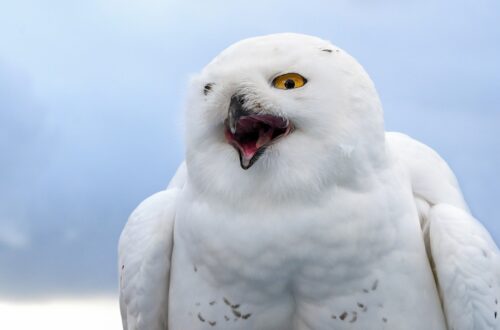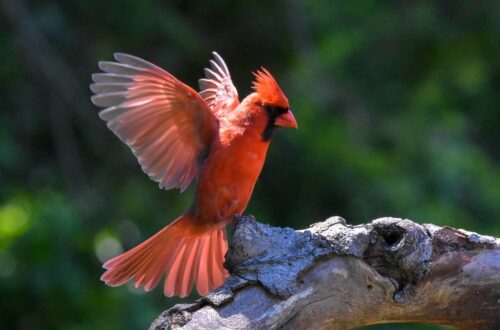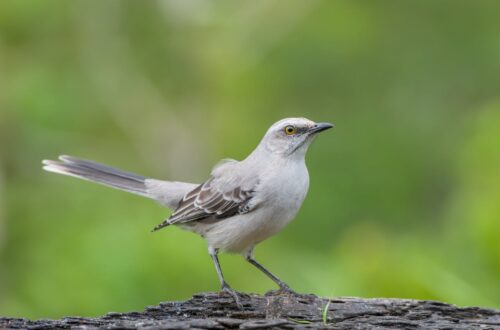
24 Fun Facts About Blue Jays: The Wise Bird of North America
Fun Facts About Blue Jays
Blue Jays, known scientifically as Cyanocitta cristata, are among the most captivating bird species found in North America. Recognized for their bright blue feathers and striking appearance, these intelligent birds have become a symbol of both beauty and intelligence in the avian world. This article explores various fascinating facts about Blue Jays. Covering their behavior, habitat, and the intriguing characteristics that make them a favorite among bird watchers and nature enthusiasts.
Blue Jays are more than just a beautiful bird; they are an essential part of the ecosystems in which they live.
Found primarily in the eastern United States and southern Canada, Blue Jays are a species of bird that has garnered significant attention for their complex social systems, loud calls, and striking blue color.
Facts About Blue Jays
Known for their noisy presence, Blue Jays are often spotted in suburban areas, forest edges, and even in large flocks during migration.
Notably, Blue Jays have a unique ability to mimic the calls of hawks. Particularly the red-shouldered hawk and the red-tailed hawk, as a strategy to protect themselves from potential predators.
Moreover, these birds are famous for their complex communication skills. Including the ability to make excellent imitations of several hawk calls. Which often leaves smaller birds in a state of alarm.
Habitat and Distribution

Where Do Blue Jays Live?
Blue Jays are commonly found in various kinds of forests, especially in oak trees and beech trees. Which provide them with ample food sources and nesting sites.
While they are predominantly found in the eastern United States, their range extends into southern Canada. Covering areas from the Atlantic coast to the Great Lakes.
Blue Jays thrive in both deep forests and suburban areas. Making them a common sight for bird watchers across North America.
Migration Patterns
Although some Blue Jays are migratory, others are year-round residents in their habitats. The migration patterns of Blue Jays remain somewhat mysterious. With some birds traveling great distances during the fall, while others stay put.
Interestingly, these birds are often seen in large flocks during migration. Sometimes numbering in the hundreds, as they move to regions with more abundant food sources.
Physical Characteristics
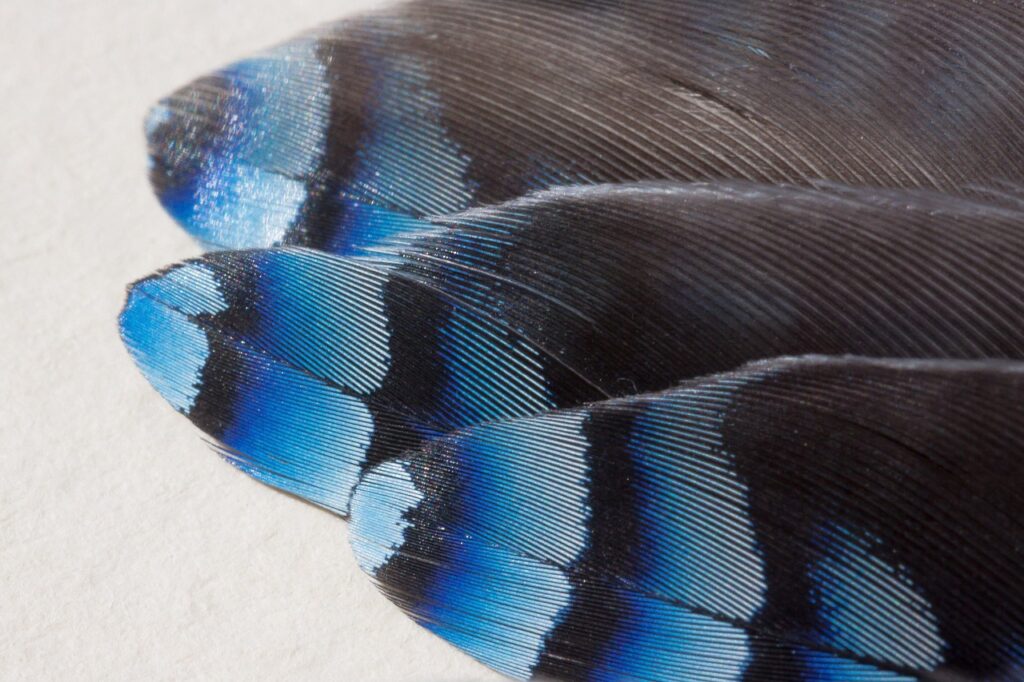
What Makes Blue Jays Blue?
One of the most interesting facts about Blue Jays is the origin of their blue color. Unlike other birds, Blue Jays do not have blue pigments in their feathers.
Instead, their bright blue feathers result from light scattering, specifically the scattering of visible light by the microscopic structure of the feathers.
This phenomenon, known as the Tyndall effect, is what makes the feathers appear blue to the human eye.
The Blue Jay Feather
Another fascinating aspect of Blue Jays is their perky crest and long tail, which add to their distinctive appearance. The black plumage around their neck and the bright blue feathers on their wings make them easily recognizable.
Additionally, the blue jay’s feather is often collected by bird enthusiasts. Not only for its beauty but also as a symbol of the bird’s intelligence and adaptability.
In the next section, we will delve deeper into the behavioral traits of Blue Jays. Their feeding habits, and their role in the ecosystem. Stay tuned for more intriguing facts about these beautiful birds.
Behavioral Traits of Blue Jays
Social Structure and Communication
Blue Jays are known for their complex social systems, often seen in family groups or loose flocks. During the breeding season, these birds are highly territorial and are known to aggressively defend their nest sites from intruders, including other bird species.
Interestingly, Blue Jays also exhibit a strong sense of family. With both male and female Blue Jays participating in feeding and protecting their young.
The young Blue Jays stay with their parents for several weeks after leaving the nest, learning essential survival skills.
In terms of communication, Blue Jays are remarkably vocal birds. Their wide variety of sounds includes a range of loud calls. Which serve different purposes, from alarm calls to mating calls.
One of the most intriguing facts about Blue Jays is their ability to mimic the calls of hawks. This skill is used not only to scare off predators but also to deceive other birds.
Allowing the Blue Jays to have first access to food sources like sunflower seeds and corn.
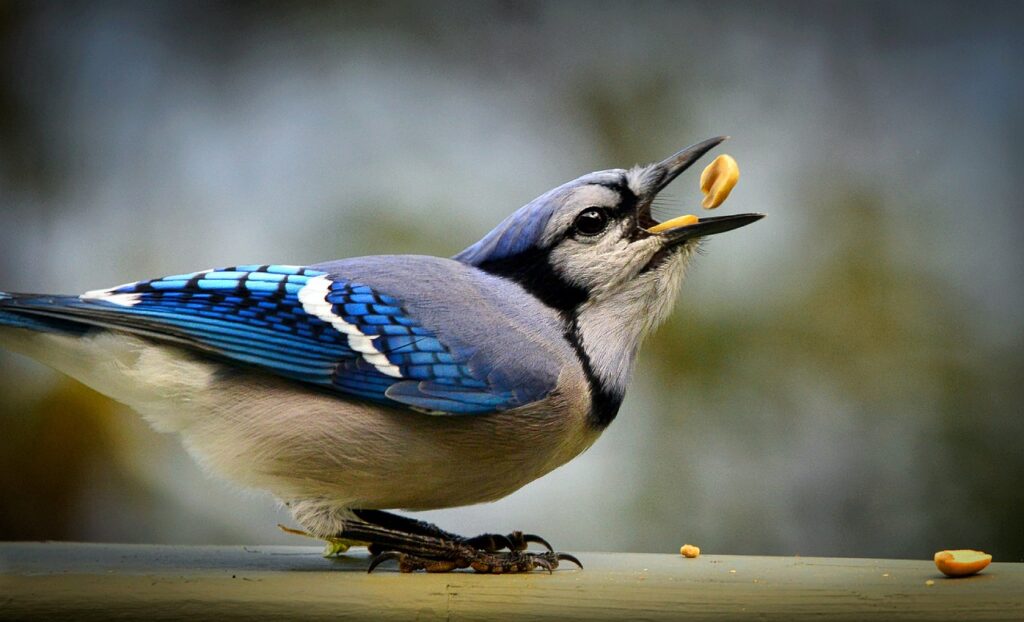
Feeding Habits and Diet
Blue Jays are omnivorous and have a varied diet that includes seeds, nuts, fruits, and insects. Oak trees are particularly significant for Blue Jays, as they are a major source of acorns, which these birds are known to cache for later consumption.
This behavior plays an essential role in forest ecology, as the forgotten acorns often sprout into new oak trees.
In addition to acorns, Blue Jays are frequent visitors to bird feeders, where they enjoy sunflower seeds and other food items.
They are known to be opportunistic feeders, taking advantage of a wide variety of food sources available in their habitat.
Blue Jays are also known to feed on small rodents, eggs of other birds, and occasionally even paint chips, which provide essential minerals.
READ NEXT: Interesting Facts About Cardinals
Intelligence and Problem-Solving
Blue Jays are among the most intelligent birds in North America, often compared to crows and ravens in terms of their cognitive abilities.
These birds have been observed using tools to open nuts and have displayed remarkable problem-solving skills in various experiments.
Captive Blue Jays, in particular, have demonstrated an ability to learn from their environment, adapting their behaviors to solve complex tasks.
Moreover, Blue Jays have a keen memory, which they use to remember the locations of their food caches.
This ability to plan for the future by storing food is a testament to their intelligence. Additionally, Blue Jays have been known to mimic human speech, although this behavior is less common than their mimicry of hawk calls.
Nesting and Reproduction
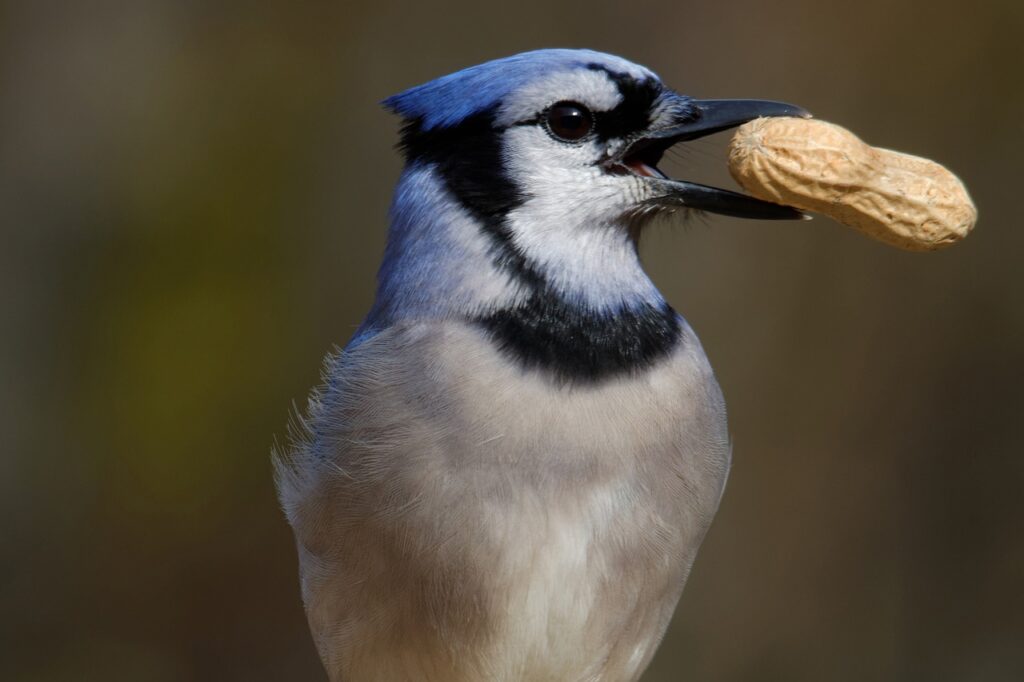
Nest Construction and Mating Season
During the mating season, which typically occurs in late spring, Blue Jays engage in elaborate courtship displays.
The male Blue Jay often presents food to the female as part of the courtship ritual, and if accepted, the pair will proceed to build a nest together.
The nests are usually cup-shaped and are constructed from twigs, grass, and other plant materials. These nests are typically found in the forks of trees, well-hidden from potential predators.
The eggs of Blue Jays are pale blue or greenish with brown spots, and the female usually lays between 3 to 6 eggs per clutch. Both parents take turns incubating the eggs, which hatch after about 16 to 18 days.
The young birds are born altricial, meaning they are completely dependent on their parents for food and protection in the early stages of their life.
Raising the Young
Once the young Blue Jays hatch, they are fed a diet rich in insects, which provides them with the necessary protein for growth.
As the chicks grow, their diet gradually shifts to include more plant material, such as seeds and fruits. The parents are highly attentive, constantly bringing food to the nest and teaching the young birds essential survival skills, such as foraging and recognizing the calls of hawks and other potential threats.
In the next section, we will explore the migration patterns of Blue Jays, their role in different ecosystems, and some of the interesting cultural references associated with these remarkable birds.
Migration Patterns and Ecological Role

Blue Jays’ Migration Behavior
Blue Jays are partial migrants, meaning that not all individuals of the species migrate. Some Blue Jays, particularly those in the northern part of their range, migrate south during the winter, while others remain in their breeding territories year-round.
The reasons behind their inconsistent migration patterns are not fully understood, though it is believed that food availability plays a significant role.
In years when acorn production is low, more Blue Jays may migrate in search of food sources. These migrations can cover great distances, with some birds traveling from the Great Lakes region to the southern United States.
Ecological Contributions
Blue Jays play a crucial role in the ecosystems they inhabit. One of their most significant contributions is their involvement in seed dispersal, particularly for oak trees.
By caching acorns and other seeds, Blue Jays inadvertently plant new trees, which helps maintain forest health and biodiversity.
This behavior is especially important following the last glacial period, as it allowed forests to expand into previously ice-covered regions.
Moreover, Blue Jays are also known to affect the populations of other species of birds. Their aggressive nature and ability to mimic the call of a hawk often intimidate smaller birds, allowing Blue Jays to dominate feeding areas.
Despite this, their presence is vital to the balance of their habitats, as they help control insect populations and contribute to the dispersal of various plant species.
Blue Jays in Culture and Symbolism
Cultural References and Symbolism
Blue Jays have captured the imagination of many cultures and have been featured prominently in various forms of art, literature, and sports.
The Toronto Blue Jays, a professional major league baseball team, have adopted the bird as their mascot, symbolizing the strength, intelligence, and resilience that the Blue Jay represents.
The bird’s bright blue feathers and perky crest have made it a symbol of beauty and communication, often depicted in Native American folklore as a messenger and a protector.
In addition to their role as a sports mascot, Blue Jays have also been a popular subject in bird watching, with enthusiasts drawn to their striking appearance and interesting behaviors.
The Cornell Lab of Ornithology lists Blue Jays as one of the most frequently observed birds in North American bird feeders, particularly in the eastern United States and southern Canada.
Their loud calls and complex social interactions make them a fascinating species to observe.
Frequently Asked Questions: Facts About Blue Jays
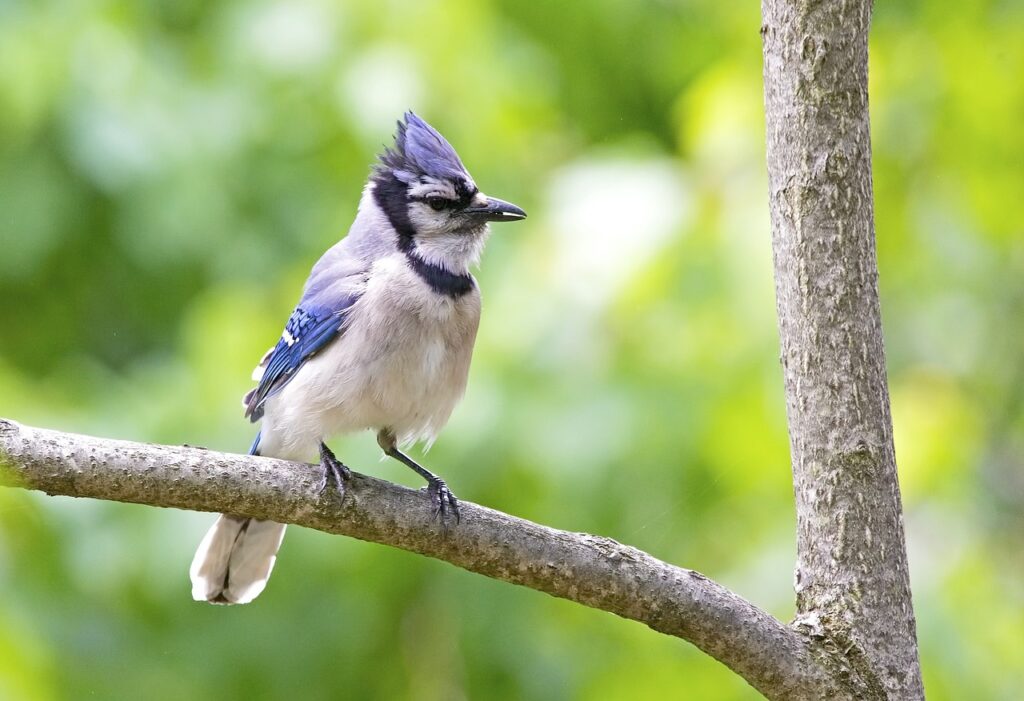
Why do Blue Jays mimic the calls of hawks?
Blue Jays mimic the calls of hawks as a defensive mechanism to protect themselves and their food sources from predators and to scare off other birds.
Do all Blue Jays migrate?
Not all Blue Jays migrate. Some are year-round residents, while others migrate depending on food availability and environmental conditions.
What do Blue Jays eat?
Blue Jays have an omnivorous diet that includes seeds, nuts, fruits, insects, and occasionally small rodents. They are also known to visit bird feeders for sunflower seeds and other food items.
How do Blue Jays contribute to forest ecology?
Blue Jays contribute to forest ecology by dispersing seeds, particularly acorns, which helps with the regeneration of oak trees and other plant species.
What is the significance of a Blue Jay’s feather?
A Blue Jay’s feather is often seen as a symbol of intelligence and adaptability, reflecting the bird’s bright blue color and its ability to thrive in various environments.
READ NEXT: Best Secrets About Snowy Owls
Facts About Blue Jays Conclusion
Blue Jays are truly remarkable birds, known for their intelligence, striking appearance, and complex social behavior. From their role in seed dispersal to their ability to mimic the calls of hawks, these birds play a vital part in the ecosystems they inhabit.
Whether observed in the wild or appreciated as a cultural symbol, Blue Jays continue to fascinate and inspire those who encounter them. Their presence in North American forests and suburban areas serves as a reminder of the beauty and complexity of nature.


